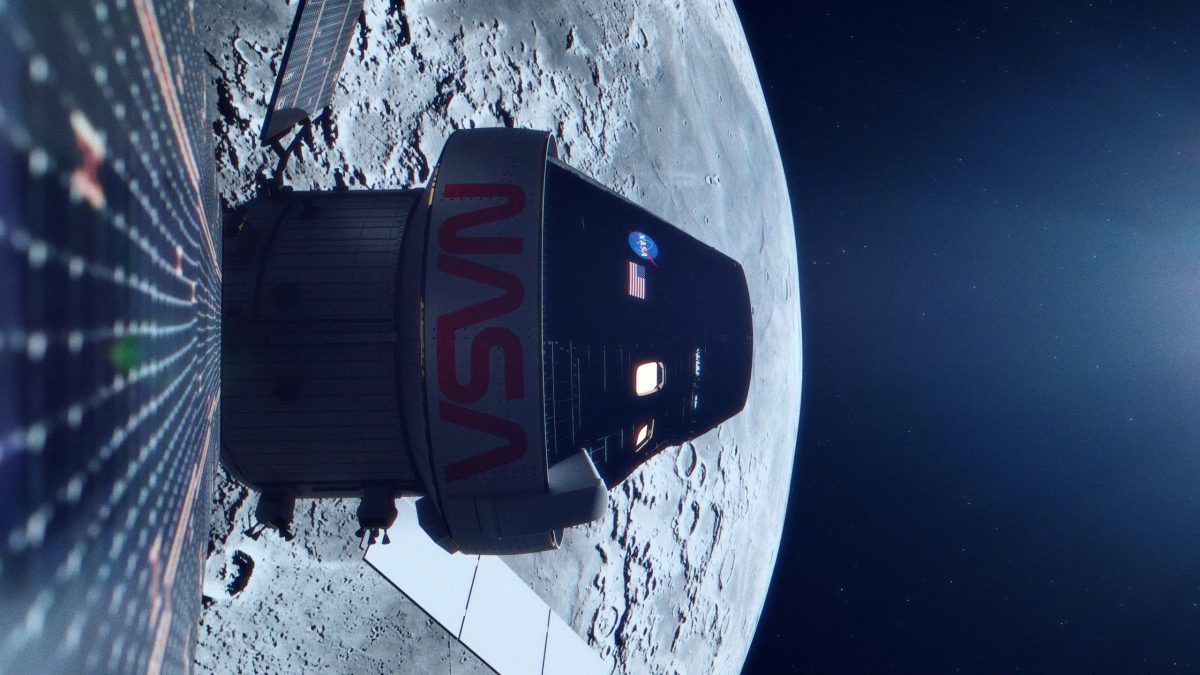Artemis I will be the first integrated flight test of NASA’s deep space exploration system: the Orion spacecraft, Space Launch System (SLS) rocket and the ground systems at Kennedy Space Center in Cape Canaveral, Florida. The first in a series of increasingly complex missions, Artemis I will be an uncrewed flight that will provide a foundation for human deep space exploration, and demonstrate our commitment and capability to extend human existence to the Moon and beyond. During this flight, the uncrewed Orion spacecraft will launch on the most powerful rocket in the world and travel thousands of miles beyond the Moon, farther than any spacecraft built for humans has ever flown, over the course of about a three-week mission. Credit: NASA/Liam Yanulis
Watch live as NASA’s Orion spacecraft performs a close approach of the lunar surface on its way to a distant retrograde orbit (DRO). Orion will pass around 80 miles above the lunar surface, as it progresses toward a DRO, a highly stable orbit thousands of miles beyond the Moon.
During the Artemis I flight test, launched on November 16, Orion will travel 280,000 miles (450,000 km) from Earth and 40,000 miles (64,000 km) beyond the far side of the Moon, carrying science and technology payloads to expand our understanding of lunar science, technology developments, and deep space radiation.
Watch Live: Artemis I Close Flyby of the Moon
NASA’s Artemis I – Flight Day Five: Orion Enters Lunar Sphere of Influence Ahead of Lunar Flyby
Sunday, five days into the 25.5-day Artemis I mission, Orion continued on its trajectory toward the Moon. At NASA’s Johnson Space Center, flight controllers in the White Flight Control Room in Houston captured additional imagery of the Moon using the optical navigation camera. Gathering imagery of the Earth and the Moon at different phases and distances will provide an enhanced body of data to certify its effectiveness as a location determination aid for future missions under changing lighting conditions.
At 6:12 a.m. CST, Orion completed its third outbound trajectory correction burn, firing the auxiliary thruster engines for a duration of 6 seconds at a rate of 3.39 feet per second. This accelerated Orion and adjusted the spacecraft’s path en route to the Moon. Which of Orion’s service module engines – reaction control, auxiliary, or orbital maneuvering system – to use for a particular maneuver is determined by the amount of speed change needed.
The spacecraft entered into the lunar sphere of influence at 1:09 p.m. CST, making the Moon, instead of Earth, the main gravitational force acting on the spacecraft. Overnight, Orion will conduct the fourth outbound trajectory correction burn in advance of the outbound powered flyby burn. Flight controllers will conduct the outbound powered flyby burn by firing the orbital maneuvering system engine for 2 minutes and 30 seconds to accelerate the spacecraft, harness the force from the Moon’s gravity, and direct it toward a distant retrograde orbit beyond the Moon.

Artemis I lunar flyby artist’s concept. Credit: NASA/Liam Yanulis
The outbound powered flyby burn is the first of a pair of maneuvers required to enter a distant retrograde orbit around the Moon. NASA will cover the maneuver live starting at 7:15 a.m. EST (4:15 a.m. PST) on the agency’s website, NASA Television, and the NASA app. The outbound powered flyby will begin at 7:44 a.m., with Orion’s closest approach to the Moon targeted for 7:57 a.m., when it will pass about 80 miles above the lunar surface. Engineers expect to lose communication with the spacecraft as it passes behind the Moon for approximately 34 minutes starting at 7:26 a.m. The Goldstone ground station, part of NASA’s Deep Space Network, will acquire the spacecraft once it emerges from behind the Moon.
Mission managers currently have two active anomaly resolution teams. Anomaly resolution teams are a standard part of managing the mission by pulling together a team of technical experts to focus on a specific issue by examining data to understand the implications in a particular system. Activating a separate team for this work enables engineers and flight controllers to continue focusing on commanding and monitoring the spacecraft and assessing the progress of the flight test.
One team is currently looking at the star tracker system to understand a number of faults in the random access memory, which have been successfully recovered with power cycles. A second team is analyzing a few instances in which one of eight units located in the service module that provides solar array power to the crew module, called a power conditioning and distribution unit umbilical latching current limiter, opened without a command. The umbilical was successfully commanded closed each time and there was no loss of power flowing to avionics on the spacecraft. Both systems are currently functioning as required, and there are no mission impacts related to these efforts. Analyzing the data for these systems and understanding their behavior during an active flight test while the hardware is in the deep space environment will improve mission operations on Artemis I and future missions.
As of 1:25 p.m. CST on November 20, Orion had traveled 232,683 miles from Earth and was 39,501 miles from the Moon, cruising at 371 miles per hour. See which antennas are communicating with Orion in real-time on Deep Space Network Now and track Orion via the Artemis Real-Time Orbit Website, or AROW.
Share your story or advertise with us: Whatsapp: +2347068606071 Email: info@newspotng.com










